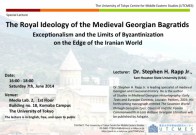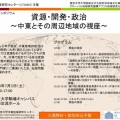The Royal Ideology of the Medieval Georgian Bagratids: Exceptionalism and the Limits of Byzantinization on the Edge of the Iranian World
特別講演会
 Starting in the tenth and eleventh centuries, the Georgian Bagratids portrayed themselves as a sharp break from what had come before: their unprecedented achievements demanded exceptional commemoration and a unique history. While Bagratid Georgia attained unprecedented political heights as it looked to Byzantium as never before, the royal family nevertheless stood on the shoulders of giants. From a literary perspective I mean this quite literally since the pre-Bagratid historiographical tradition, which was established especially in the middle and late Sasanian periods, celebrated gigantic warriors and hero-kings of an Iranic type. I shall demonstrate that many of the innovations habitually credited to the Bagratids—including historiographical traditions, royal imagery, a native calendar system (k‛oronikoni), and the toponym Sak‛art‛velo, “Georgia”—either belong entirely to the pre-Bagratid era or have strong pre-Bagratid roots. This pattern is evident not only in the political realm, whose image was meticulously sculpted by the Bagratids and their adherents, but also in the ecclesiastical, social, literary, linguistic, and economic spheres.
Starting in the tenth and eleventh centuries, the Georgian Bagratids portrayed themselves as a sharp break from what had come before: their unprecedented achievements demanded exceptional commemoration and a unique history. While Bagratid Georgia attained unprecedented political heights as it looked to Byzantium as never before, the royal family nevertheless stood on the shoulders of giants. From a literary perspective I mean this quite literally since the pre-Bagratid historiographical tradition, which was established especially in the middle and late Sasanian periods, celebrated gigantic warriors and hero-kings of an Iranic type. I shall demonstrate that many of the innovations habitually credited to the Bagratids—including historiographical traditions, royal imagery, a native calendar system (k‛oronikoni), and the toponym Sak‛art‛velo, “Georgia”—either belong entirely to the pre-Bagratid era or have strong pre-Bagratid roots. This pattern is evident not only in the political realm, whose image was meticulously sculpted by the Bagratids and their adherents, but also in the ecclesiastical, social, literary, linguistic, and economic spheres.
Thus, if one speaks of a Bagratid “revolution,” we must neither blindly accept Bagratid exceptionalism nor depict the Bagratid accomplishment as having materialized out of thin air. Instead, the Bagratids—who ruled the Georgian lands for a thousand years—borrowed freely from the past. But instead of slavishly following what had come before, they creatively adapted, refined, and extended it according to their particular needs. Simultaneously, the Bagratids deliberately imagined themselves as a radical departure from preceding Caucasian dynasties. This was most evident in their unprecedented orientation towards Constantinople, their claim of equal status with the Byzantine emperors (through a Davidic origin and not through the Byzantines’ Eusebian theory of Christian kingship), and the selective “Byzantinizing” of the Georgian Church.
Dr. Stephen H. Rapp Jr. is leading specialist of medieval Georgian and Caucasian history. He is the author of Studies in Medieval Georgian Historiography: Early Texts and Eurasian Contexts, Louvain: Peeters, 2003. His forthcoming monograph entitled The Sasanian World through Georgian Eyes: Caucasia and the Iranian Commonwealth in Late Antique Georgian Literature will be published by Ashgate.
| 講師 | Dr. Stephen H. Rapp Jr., (Sam Houston State University (USA)) |
| 日時 | 16:00 – 18:00 Saturday 7th, June 2014 |
| 会場 | Media Lab. 2, 1st Floor Building no. 18, Komaba Campus The University of Tokyo |
| The lecture is in English, free, and open to public | |
| ダウンロード | チラシPDF |


